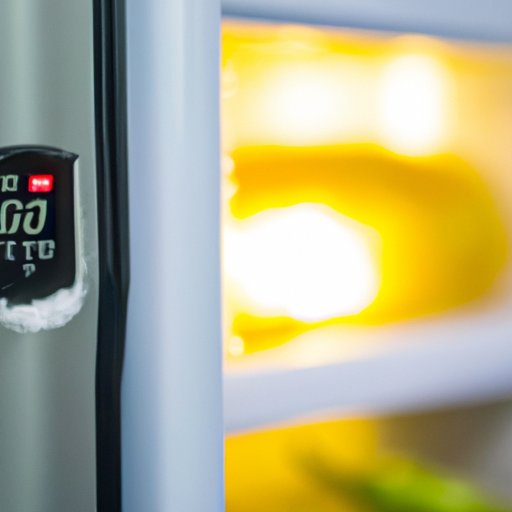Introduction
Without a doubt, one of the most important appliances in our homes is the refrigerator. Whether it’s storing groceries or leftovers, it’s essential for keeping food fresh and safe. But what many people don’t realize is that the temperature of your refrigerator can have a huge impact on the quality and safety of the food inside it. In this article, we’ll explore what the ideal temperature for refrigerators should be, and how to make sure yours is set correctly.
Exploring the Ideal Temperature for Refrigerators: What Should You Set Yours At?
According to the United States Department of Agriculture (USDA), the ideal temperature for refrigerators is 40°F (4.4°C) or lower. This temperature range helps slow the growth of bacteria that can cause foodborne illness. It’s also important to note that the temperature of a refrigerator can vary by a few degrees, so it’s important to check the temperature with a thermometer if you’re concerned.
In addition to the USDA recommendation, there are several factors that can affect the temperature of your refrigerator. The size and age of the refrigerator, as well as the amount of food inside it, can all play a role in the temperature. For example, an older refrigerator may not be able to maintain a consistent temperature, while a larger refrigerator may struggle to cool down when it’s full of food.
The Science Behind Refrigerator Temperature Settings: What’s Best For Your Food Safety?
When it comes to food safety, understanding the science behind refrigerator temperatures is key. Bacteria need warm temperatures to grow and multiply, and the higher the temperature, the faster they’ll grow. That’s why it’s so important to keep your refrigerator at the recommended temperature of 40°F (4.4°C) or lower. At this temperature, bacteria will take longer to multiply, which means your food will stay fresher for longer.
Another important factor to consider is consistency. Keeping the temperature of your refrigerator consistent is essential for food safety. If the temperature fluctuates too much, bacteria can grow more quickly and your food can spoil faster. That’s why it’s important to check the temperature of your refrigerator regularly and adjust the settings if needed.

Keeping Your Food Safe: Setting Your Refrigerator to the Right Temperature
Now that you know the science behind refrigerator temperatures, it’s time to start setting yours to the right temperature. The first step is to find the temperature control dial on your refrigerator. Most models have a dial or slider that allows you to adjust the temperature. Generally, the colder the setting, the better. However, it’s important to keep in mind that if the temperature is set too low, your food may freeze.
Once you’ve found the temperature control dial, it’s a good idea to invest in a refrigerator thermometer. These thermometers are inexpensive and can help you keep track of the temperature inside your refrigerator. Place the thermometer in the center of the refrigerator and check it periodically to make sure the temperature is staying consistent.
Don’t Risk Spoilage: Here’s How to Get the Right Refrigerator Temperature
Now that you know how to set the temperature of your refrigerator, it’s time to put the tips into practice. Start by adjusting the temperature dial to the coldest setting that won’t freeze your food. Then, place a refrigerator thermometer in the center of the refrigerator and check it regularly to make sure the temperature is staying consistent. Finally, make sure you’re not overloading your refrigerator. If it’s too full, it won’t be able to maintain the right temperature.
Refrigerator Temperature Settings: Making Sure Your Food Stays Fresh and Safe
Setting the right temperature for your refrigerator is one of the best ways to keep your food fresh and safe. Not only will it help slow the growth of bacteria, but it will also ensure that your food stays at its optimal temperature. Plus, setting the right temperature can help reduce food waste, since you won’t have to throw out spoiled food as often.
However, it’s important to remember that there are some common mistakes to avoid when setting the temperature of your refrigerator. For example, never set the temperature too low, as this could cause your food to freeze. Additionally, make sure you’re not overloading your refrigerator, as this can make it difficult for the appliance to maintain a consistent temperature.
Conclusion
Setting the right temperature for your refrigerator is essential for keeping your food fresh and safe. By following the tips outlined in this article, you’ll be able to set the correct temperature and keep your food from spoiling. Remember, the ideal temperature for refrigerators is 40°F (4.4°C) or lower, and it’s important to check the temperature regularly with a thermometer.


